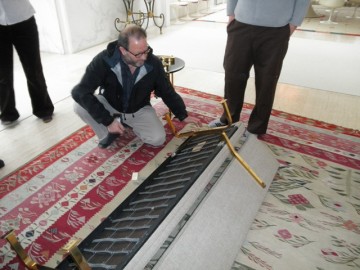
Daniel Ostroff inspects the underside of a customized Eames compact sofa at the Miller House and Garden. Photo by Tricia Gilson.
Yesterday, in collaboration with Tricia Gilson, I presented Part I of an interview with Eames expert and film producer, Daniel Ostroff. He is a Los Angeles-based film producer, researcher, curator, and collector. He is also the producer and editor of EamesDesigns.com, a consultant for Herman Miller, and has been sitting on an Equa Chair behind an Action Office System desk for the past 10 years.
This week, the exhibition he curated, Collecting Eames: The JF Chen Collection, opens at JF Chen in Los Angeles. The exhibition is part of the Getty’s massive Pacific Standard Time project and consists of 450 pieces, with a corresponding 135 page catalog with a preface by Eames Demetrios and an essay by Dan (available soon on Amazon, or by e-mail here).
RM & TG: When you visited the IMA’s Miller House & Garden this year, we looked at all of the Eames furniture in the house. Of particular note is that you described the Eames PSC-1 in a girl’s bedroom as a “marriage of chairs,” a “historic Eames chair;” “like a Japanese ceramic with staples in it.” Is this a common practice, for owners to marry different Eames chair components together?
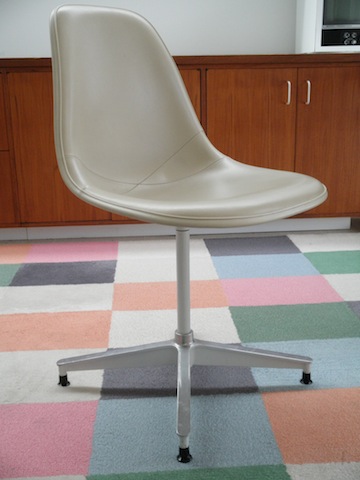
PSC-1 Chair at the Miller House and Gardens (MH2010.41.1). The chair consists of a later base added to an earlier shell. Photo by Tricia Gilson, Copyright Eames Office and the Indianapolis Museum of Art.
DO: I can’t say whether or not it is a common practice, but I am delighted when I see pieces that show signs of attention from their original owners. It means that someone valued this piece enough to modify it to suit their needs.
Now, an important distinction should be made between this practice, what the original owners did, and what some dealers do. I think when an antique dealer makes such changes in order to enhance the value of a piece, he is rendering it valueless.
I have my own collection of well-loved, well-used Eames chairs. A couple favorites come to mind: a walnut DCW that I rescued from a dealer before it was refinished; its finish is original and it is engraved overall with a couple decades of what I imagine to be school kids scratching their names into the veneer with pens and pencils.
And then I have a mid 1950s Eames LCM that was originally coated with Eames red aniline dye. But at some point, some owner decided that they needed a chair with antique white paint, and that’s what they put on it, very thickly. I remember from my childhood when “antique white” was in vogue. I think my parents painted my childhood bedroom furniture with antique white, with that streaky black stuff in it.
I think examples like these two are beautiful in and of themselves, but if you have to think something about them, think this: Eames designs look better with age, and also, you can personalize them to your own needs and they still look great.
RM & TG: What do you think the Eameses would have thought of this practice?
DO: They did it themselves. In the Eames House living room there’s a round George Nelson walnut tabletop on an early Eames solid cast aluminum base. In the Eames House kitchen is another Eames cast aluminum base which supports a square piece of plywood that has a TV on top.
Again, this is much different than what many dealers and collectors do now, where they marry various Eames parts to create something that they think is more desirable. I have heard that collectors in Europe are buying Eames shells and bringing them over and putting the shells on reproduction bases. I don’t know what to call those. I guess they are chairs, but they do not have any value in terms of scholarship or connoisseurship.
Charles and Ray Eames made complete designs, they did not do “mix and match” kits. If you bought an Eames design for the most part you got it and you get it now, intact, from the factory. That’s what probably has the most value: intact, all original parts, as it left the factory, Eames design. However, I think it’s just as valid to consider seriously pieces that were well-loved and well-used and sometimes well-repaired by their original owners, just like we treasure Windsor chairs that have two centuries of various over painting.
RM & TG: So they liked their furniture to develop a certain kind of patina?
I don’t think they wanted their furniture to develop a patina, I think they wanted to give their customers products that would provide years of service and performance. However, that sometimes folks would love their Eames designs so much that they would repair them, maybe relates to sock darning. Charles often said that his ambition was to have really well-darned socks. And I think darned socks are like an Eames LTR I have, which developed a bit of a separation in the wire base, and this happened after the user used the table as a step stool for twenty years, and this separation was repaired by its original owner, who worked for ten years at the Eames Office, with a bit of coat hanger wire.
Ray was the same way. The Eames family does fantastic, historic and meaningful exhibits at the Eames Office at 850 W. Pico in Santa Monica. Once they exhibited some of Charles Eames’ shirts and some of Ray Eames’ dresses. On many you could see signs of re-weaving and darning.
Carla Hartman, the Education Director of the Eames Office, tells a wonderful story about Ray. Ray and Charles were at a party, and they rarely attended parties, they mostly worked seven days a week until eleven at night, and that is not an exaggeration. At the party Ray had her back to one woman who whispered to her companion, upon seeing a darned bit on the back of Ray’s cape, “You’d think Mr. Eames would buy his wife a new cape!” There’s a morality in that too, why throw something away that you love and enjoy and can still use, just because there’s a hole in it?
RM& TG: Last month Jeff Jamieson spoke about how the look of Donald Judd’s furniture has evolved over time; have you found material that discusses how the Eames thought about their work changing over time?
DO: I have found, over the years, that Charles and Ray expressed themselves very, very well with regard to their designs, and what they were thinking when they designed them. Right now I am working on an anthology of Eames speeches, letters, and interviews. In this project I have found that the Eames’ wisdom is as relevant to today’s problems, as it was to problems in the past. They did not just talk the talk, they walked the walk.
Charles and Ray noted that they thought about how something would look in ten years, in twenty years, in fifty years. Earlier this year I acquired an Eames Soft Pad Chair (EA434), in leather, that was in the Saarinen-designed bank (Irwin Union Bank and Trust) in Columbus, Indiana. I can tell from the markings and the ink stamped model number on the chair, that the bank acquired this chair in 1970. I acquired it in 2011. That means for 41 years, bankers sat on it. Well, that chair looks more beautiful in some ways, than a new Eames soft pad chair does. And that happened because Charles and Ray considered that when they designed it.
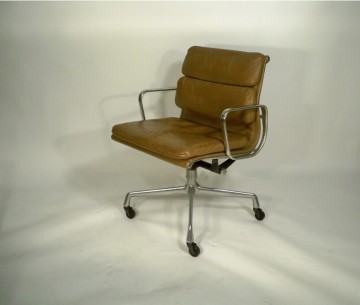
Eames Soft Pad Chair acquired from Euro Saarinen-designed bank in Columbus, IN. Photo Daniel Ostroff. Copyright Eames Office.
There are plenty of things that we buy and sell to one another that look worse when we get them home and use them for a week. In many cases Eames products look better when they are used for a little while.
RM & TG: As you note in your book, Modern Classic: the Eames Plastic Chair, over the past 60 years the plastic shells of Eames chairs have changed; would you talk about how or if the suppliers for the shells have had an impact on the appearance of the final product?
DO: I suspect that it was more often that “the Eames” (Alexander Girard referred to Charles and Ray as “The Eames”) had an impact on the suppliers, than that the suppliers had an impact on them.
Starting with the general, think about anything you do in life. If you play tennis with people who are better than you, you get better at your game. And better is probably the wrong word, because as Charles Eames once said, “Genius, baloney, we just work harder.” And that was true, even in their seventies, Charles and Ray would still be at their office at ten-thirty at night, and often barely made it home in time to watch the eleven o’clock news. Charles and Ray Eames would not delegate understanding, so when they worked with a new material or on a new subject, they worked very hard to understand its properties or its qualities very well themselves.
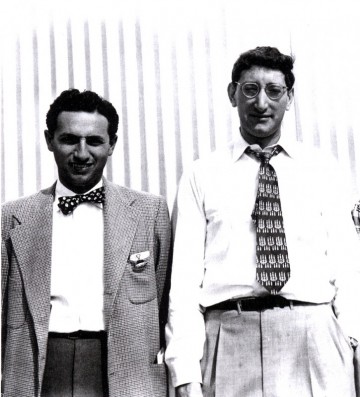
Irv Green and Sol Fingerhut at Zenith Plastics in California. Image Courtesy and Copyright Eames Office.
On EamesDesigns.com there are marvelous interviews with Sol Fingerhut and Irv Green, two men who Charles and Ray impressed into service to make the first industrially-produced plastic furniture.
It would be better for people to actually go read the interviews, but I’ll quickly summarize it: World War II was over, and those two men were looking for clients. During the war they had done some work with plastics, and had worked for Corning. In the interviews they vividly describe how Charles Eames alternately grilled them about their knowledge of working with plastic, and sold them on the idea that plastic furniture as a good idea. As the relationship developed, Sol and Irv tell stories of working until midnight every night, with Charles and Ray stirring the “soup” so to speak, as Charles and Ray invented new colors for plastic, with names like Elephant Hide Grey and Sea Foam Green.
These were not cutesy names, any more than the names of their designs like DCM and DCW are cutesy names. The names that Charles and Ray gave their colors are quite descriptive and practical. Meeting Charles and Ray was the best thing that ever happened to Sol and Irv, and I understand that even after Charles died, Sol and Irv were very attentive and appreciative of Ray. I’m sure this was true of other manufacturers, although I have only begun to scratch the surface of this research. There is so much scholarship yet to be done in regard to the Eameses and manufacturers.
If people need to know some topics that need researching, drop me an e-mail or get in touch with me through the website.
RM & TG: It’s very interesting to consider how the Eameses would have adapted their practice to the “Green Movement.” Do you think the Eameses would have seen a contradiction between the Modern sense of “Good Design” and the Green Movement?
DO: With regard to good design and Charles and Ray Eames I will simply share with you one of my favorite quotes from Charles. That we have this quote is courtesy of the visionary CEO of Herman Miller, Hugh DePree, who cited this in his delightful book, Business as Unusual: The People and Principles at Herman Miller:
Once, in discussing the design of Herman Miller’s New York showroom, the words “good design” were used. Charles Eames said, “Don’t give us that good design crap. You never hear us talk about that. The real questions are: Does it solve a problem? Is it serviceable? How is it going to look in ten years?
This relates to green design. Let’s not forget something else that can be “green,” a product that is timeless, a product that doesn’t wear out, a product that has easily replaceable and easily repairable parts. How is a plastic spoon, made from soy milk and corn “green”? We use it once, we feel good because the plastic is made of “sustainable soy plastic” or some such, and then we throw it away? I think it’s maybe more “green” to make something that never goes out of style and always works.
I was delighted the other day to see in the Apple Store in Santa Monica, Eames airport tandem seating. You know how great Apple design is, but I think that if you go in that store you’ll agree with me, that the Eames seating, which hasn’t changed since it was first designed and introduced in 1961, is the best looking stuff in the store. And it’s practical and comfortable.
Fundamental to Charles and Ray’s design of that tandem seating is the fact that the seat and back cushions are interchangeable. It’s one of the greatest Eames designs ever and we take it for granted because we see it in hundreds of airports all over the world.
There are many things I love about airport tandem seating, but here are two. Charles and Ray thought about these two constraints, among others: that the tandem seating be sturdy enough that a weary adult businessman or woman could flop themselves down on it, with a heavy briefcase, and be supported. But light enough and “slide-y” enough, that at the end of the evening, a janitor could easily move it for mopping. And secondly, those interchangeable pads: Imagine you are in charge of resources for an airport. Because the back and seat pads are interchangeable, you only have to order “replacement pads.” You don’t have to send some clerk on your staff around to tell you how many “backs” you need and how many “bottoms.” The pads will last for twenty years or more before they need replacing, and when twenty or thirty years are up, the aluminum and steel frames still look awesome and work great.
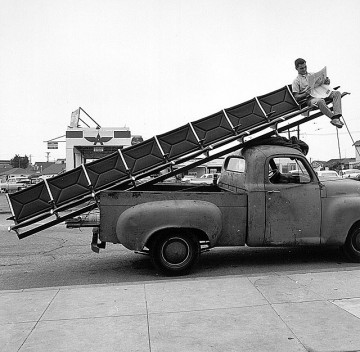
Staff Member Jim Sommers Sitting in Eames Tandem Sling Seating, circa 1962. Image courtesy Library of Congress.
RM & TG: It’s almost as if many of the ideas that the Eameses were pursuing are as relevant today as they were just after the end of World War II.
DO: To answer this question, I’d like to reference the Eames Solar Toy of 1959, which is often misunderstood and misnamed the “Do Nothing Machine.” In the book I am working on now it becomes clear that Charles and Ray Eames had generous and wise hearts. When asked by Alcoa to make a “toy” out of aluminum, they demurred. They didn’t think the world needed an “aluminum toy” just for fun and advertising.
Many designers participated in the Alcoa Forecast Program, and various things were produced in aluminum, including some furniture and storage systems. When pressed by Alcoa, Charles and Ray did think that there was something the world needed. It occurred to them, in 1959, a “Mad Men” ish world of big gas guzzling cars and martini guzzling ad men, that the world needed reminding that our resources are not infinite, and they made a toy that showed the virtues of a renewable energy source: the sun.
About as far from a “Do nothing” device as there ever was, Charles and Ray showed us, in a delightful manner, that the sun can power our devices. Here’s to much more real scholarship to come, about a very relevant design duo, who the world needs now more than ever.

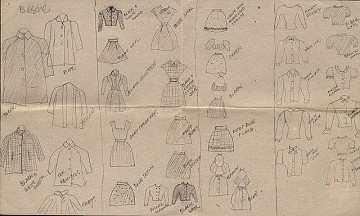
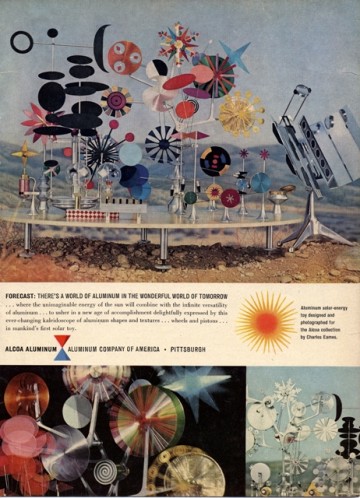



Pingback: The Top Ten U.S. Online Contemporary Conservation Projects from 2011 | Art21 Blog
Pingback: Inspiration and the Eames | Indianapolis Museum of Art Blog